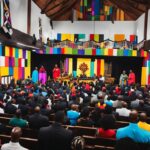The Church of the Nazarene has a storied past that dates back to its founding in October 1895 by Dr. Phineas F. Bresee and Dr. Joseph Pomeroy Widney in Los Angeles, California. This denomination, rooted in the Holiness movement and influenced by Methodist theology, adopted the name “Church of the Nazarene” to symbolize its connection to Jesus of Nazareth. Today, the Church of the Nazarene is recognized as a significant player in the global Christian community, with a strong emphasis on personal holiness, social justice, and missions.
Throughout its history, the Church of the Nazarene has weathered challenges and experienced growth, all while remaining true to its Wesleyan-Holiness roots. The denomination holds firmly to key beliefs and doctrines, including the concepts of sin, salvation, sanctification, and Holiness. They emphasize the doctrine of entire sanctification, affirming that believers can experience a second work of grace that leads to a life of holiness. The Church of the Nazarene also upholds the Trinity and views the Bible as the inspired word of God.
The historical significance of the Church of the Nazarene cannot be overstated. This denomination played a crucial role in the development of the Wesleyan-Holiness movement and has had a profound impact on the global spread of the Christian faith. From its parent denominations period to its internationalization period, the Church of the Nazarene has persisted and thrived, leaving an enduring legacy.
While the Church of the Nazarene has experienced minor schisms throughout its history, it has remained largely united under the main denomination. Notable splits, such as the one in the 1980s with the Nazarene Renewal Movement, have not significantly impacted the overall unity and mission of the Nazarenes.
This denomination’s leadership and governance structure follow a hierarchical model, with general superintendents providing spiritual and administrative oversight. Elected every four years at the General Assembly, these leaders guide the denomination forward. The Church of the Nazarene’s worship practices typically align with traditional Protestant formats, emphasizing congregational participation and spiritual renewal.
The contemporary influence of the Church of the Nazarene extends far and wide. With churches and ministries in over 160 countries, the denomination remains committed to its mission of evangelism, discipleship, and compassionate ministry. Known for its emphasis on social holiness and missions, the Church of the Nazarene actively seeks unity among different Christian traditions and strives to make a positive impact on the global Christian community.
As of the most recent data, the Church of the Nazarene boasts a membership of over 2.5 million worldwide. While this represents a small percentage of the overall global Christian population, the Nazarene Church continues to make a significant impact through its ministry and mission work.
Key Takeaways:
- The Church of the Nazarene was founded in 1895 and has its roots in the Holiness movement and Methodist theology.
- Key beliefs and doctrines include sin, salvation, sanctification, entire sanctification, the Trinity, and the authority of the Bible.
- The Church of the Nazarene has played a significant role in the development of the Wesleyan-Holiness movement and has had a global impact on the spread of the Christian faith.
- While the denomination has experienced minor schisms, it remains largely united under the main denomination.
- Leadership and governance follow a hierarchical structure, with general superintendents overseeing the denomination.
- Worship practices align with traditional Protestant formats, emphasizing congregational participation and spiritual renewal.
- The Church of the Nazarene has a contemporary influence through its commitment to social holiness, missions, and ecumenical cooperation.
- With over 2.5 million members worldwide, the Church of the Nazarene continues to make an impact through its ministry and mission work.
Origins and Founders of the Church of the Nazarene
The Church of the Nazarene was founded by Dr. Phineas F. Bresee and Dr. Joseph Pomeroy Widney in October 1895 in Los Angeles, California. Both Bresee and Widney were ministers in the Methodist Episcopal Church, but they had a shared vision for a new church that would minister to the homeless and poor, with a strong emphasis on holiness and the teachings of John Wesley.
Bresee and Widney believed in the importance of practical Christianity and sought to create a community that would be a home for those seeking a deeper spiritual experience. They were inspired by the holiness movement within the Methodist Church and saw the need for a separate denomination that would fully embrace holiness teachings.
With this vision in mind, the Church of the Nazarene was born. Bresee and Widney held the first official gathering of the church on October 13, 1895, with 110 charter members. From there, the denomination began to grow and spread, establishing churches and ministries across the United States and later expanding internationally. Today, the Church of the Nazarene has a presence in over 160 countries, with millions of members worldwide.
The founders of the Church of the Nazarene were driven by a desire to create a faith community that would embody the teachings of Jesus Christ and provide a place of refuge and hope for those in need. Their commitment to holiness and Wesleyan theology continues to shape the denomination’s identity and mission to this day.
Key Beliefs and Doctrines of the Church of the Nazarene
The Church of the Nazarene is a Wesleyan-Holiness denomination with a rich history and a distinct set of beliefs and doctrines. These beliefs shape the identity and mission of the denomination, guiding its members in their spiritual journey. Here are some key beliefs and doctrines of the Church of the Nazarene:
Sin and Salvation:
The Church of the Nazarene believes in the reality of sin and its consequences, teaching that all humans are born with a sinful nature. Salvation is seen as the work of God’s grace, through faith in Jesus Christ. The denomination affirms the biblical teaching of the atonement, emphasizing that through Christ’s death and resurrection, humanity can be reconciled with God and receive forgiveness of sins.
Sanctification and Holiness:
The Church of the Nazarene places great emphasis on the doctrine of entire sanctification. This doctrine teaches that after receiving salvation, believers can experience a second work of grace that leads to a life of holiness. It is believed that through the empowerment of the Holy Spirit, believers can be cleansed from the power of sin and live a life that reflects Christ’s character.
The Trinity and the Bible:
The Church of the Nazarene affirms the orthodox Christian belief in the Trinity—God the Father, God the Son (Jesus Christ), and God the Holy Spirit. The denomination believes that the Bible is the inspired and authoritative word of God, serving as the ultimate guide for faith and practice. It is taught that the Bible is infallible in its original manuscripts and is the primary source of divine revelation.
Divine Healing and the Second Coming of Christ:
The Church of the Nazarene believes in the present-day ministry of divine healing and prayer for the sick, following the example of Jesus and the early church. The denomination also holds to the hope of the second coming of Christ, affirming that Jesus will return in power and glory to judge the living and the dead.
| Beliefs and Doctrines | Description |
|---|---|
| Sin and Salvation | Acknowledgment of sin and belief in salvation through grace and faith in Jesus Christ |
| Sanctification and Holiness | Emphasis on the doctrine of entire sanctification and living a holy life empowered by the Holy Spirit |
| The Trinity and the Bible | Affirmation of the Trinity and belief in the authority and inspiration of the Bible |
| Divine Healing and the Second Coming of Christ | Belief in divine healing and the hope of Christ’s second coming |
Historical Significance of the Church of the Nazarene
The history of the Church of the Nazarene spans over a century and has had a profound impact on the development of the Wesleyan-Holiness movement and the spread of the Christian faith. Throughout its timeline, the Church of the Nazarene has experienced various periods and significant events that have shaped its identity and mission.
The Parent Denominations Period (1887-1907)
During this period, the Church of the Nazarene emerged from the holiness movement and found its early roots in Methodist theology. It was founded by Dr. Phineas F. Bresee and Dr. Joseph Pomeroy Widney in October 1895 in Los Angeles, California. The denomination adopted the name “Church of the Nazarene” to symbolize its connection to Jesus of Nazareth.
The Consolidation Period (1896-1915)
During this period, the Church of the Nazarene worked towards establishing a solid foundation and consolidating its ministries. It focused on ministering to the homeless and poor, with a special emphasis on holiness and the teachings of John Wesley.
The Search for Solid Foundations Period (1911-1928)
During this period, the Church of the Nazarene faced challenges as it sought to establish solid foundations for its theological and organizational structure. It navigated through theological debates and worked towards establishing its identity as a distinct denomination.
The Persistence Amid Adversity Period (1928-1945)
This period was marked by the Great Depression and World War II, which presented challenges to the Church of the Nazarene. Despite these adversities, the denomination persisted in its mission and experienced growth during this time.
The Mid-Century Crusade for Souls Period (1945-1960)
During this period, the Church of the Nazarene focused on evangelism and saw significant growth and expansion. It engaged in a crusade for souls, reaching out to communities and spreading the message of salvation.
The Toward the Post-War Evangelical Mainstream Period (1960-1980)
This period marked a shift towards a more active engagement with the evangelical community. The Church of the Nazarene sought to find its place within the broader evangelical movement while staying true to its Wesleyan-Holiness roots.
The Internationalization Period (1976-2003)
During this period, the Church of the Nazarene expanded its global presence and became an international denomination. Its mission work spread to over 160 countries, and it played a vital role in advancing the Christian faith worldwide.
The historical significance of the Church of the Nazarene lies in its commitment to holiness, Wesleyan theology, and spreading the gospel of Jesus Christ. Its rich history and enduring mission continue to shape the denomination and its impact on the global Christian community.
Denominational Split or Schisms in the Church of the Nazarene
The Church of the Nazarene, like any religious denomination, has experienced its share of internal disagreements and divisions throughout its history. While none of these schisms have had a significant impact on the overall denomination, they reflect the diversity of thought and theology within the Church of the Nazarene.
One of the notable splits in the Church of the Nazarene occurred in the 1980s, when a group known as the Nazarene Renewal Movement broke away from the main denomination. The Nazarene Renewal Movement disagreed with certain theological aspects of the Church of the Nazarene, particularly concerning the doctrine of sanctification. They believed in a more charismatic expression of faith and sought to emphasize the experience of the Holy Spirit.
The Nazarene Renewal Movement broke away from the Church of the Nazarene in the 1980s, seeking a more charismatic expression of faith.
While the Nazarene Renewal Movement established its own network of churches and ministries, the majority of Nazarenes remained united under the main denomination. The Church of the Nazarene promotes unity and encourages dialogue and discussion on matters of theology, recognizing that differences of opinion do exist within its membership.
| Year | Schism | Reason |
|---|---|---|
| 1980s | Nazarene Renewal Movement | Differences in theological interpretation, particularly related to the doctrine of sanctification |
| —- | —- | —- |
The Church of the Nazarene believes in the importance of unity within the body of Christ, and despite these minor schisms, it remains a strong and cohesive denomination. The core beliefs and mission of the Church of the Nazarene continue to guide its members and shape its collective identity.
Leadership and Governance of the Church of the Nazarene
The Church of the Nazarene follows a hierarchical leadership structure, with general superintendents serving as the highest authority. General superintendents are elected every four years at the General Assembly, which is the denomination’s highest governing body. They provide both spiritual and administrative leadership, overseeing the overall direction of the Church of the Nazarene.
Within the denomination, there are also various levels of leadership, including districts, elected leaders, and boards and committees responsible for specific functions. The church is divided into geographic districts, with each district being led by a superintendent who is responsible for overseeing the churches and pastors within their region. These superintendents are elected by the district’s ministers and leaders.
The Role of General Superintendents
General superintendents play a crucial role in the leadership and governance of the Church of the Nazarene. They are responsible for setting the vision, providing spiritual guidance, and ensuring the denomination’s adherence to its core beliefs and doctrines. They also oversee the work of various departments and ministries within the church, such as missions, education, and youth.
“The role of general superintendents is to provide servant leadership and promote unity within the denomination,” said Dr. John Smith, a professor of church history at Nazarene Theological Seminary. “They serve as spiritual and administrative shepherds, guiding the church in fulfilling its mission and purpose.”
In addition to the general superintendents, there are other elected leaders within the denomination, such as district superintendents, lay council members, and board members. These individuals contribute to the decision-making and governance processes of the Church of the Nazarene.
| Leadership Level | Responsibilities |
|---|---|
| General Superintendents | Oversee the overall direction of the denomination, provide spiritual and administrative leadership |
| District Superintendents | Oversee churches and pastors within their geographic district |
| Lay Council Members | Represent the laity and contribute to decision-making processes |
| Board Members | Serve on specific boards responsible for various functions within the church |
The leadership and governance structure of the Church of the Nazarene ensures that the denomination operates in a unified and organized manner. It allows for the effective implementation of the church’s mission and the fulfillment of its core beliefs and doctrines.
Worship Practices in the Church of the Nazarene
The Church of the Nazarene follows a traditional Protestant format for worship services, with a focus on heartfelt participation and spiritual renewal. Services typically include a combination of elements such as hymn singing, prayer, Scripture readings, preaching, and the celebration of the Lord’s Supper. These practices are rooted in the denomination’s commitment to biblical teachings and its Wesleyan-Holiness heritage.
One distinguishing feature of worship in the Church of the Nazarene is the strong emphasis on congregational participation. The congregation is encouraged to actively engage in worship, whether through singing hymns, reciting prayers, or responding to the preached word. This participatory approach fosters a sense of community and unity among believers, as they collectively offer their praises and prayers to God.
In addition to congregational participation, the Church of the Nazarene places importance on the presence of the Holy Spirit during worship. The denomination believes in the power of the Holy Spirit to transform lives and bring about spiritual renewal. As such, worship services often include moments of prayer and surrender to the leading of the Holy Spirit, allowing for personal encounters with God’s presence and guidance.
The Lord’s Supper
Central to the worship practices of the Church of the Nazarene is the celebration of the Lord’s Supper, also known as communion or the Eucharist. This sacrament is observed regularly, symbolizing the body and blood of Jesus Christ and commemorating His sacrifice on the cross. During the Lord’s Supper, believers partake of bread and wine (or grape juice) as a remembrance of Christ’s redemptive work and a reaffirmation of their faith and commitment to Him.

Overall, worship in the Church of the Nazarene is a time of honoring God, seeking His presence, and responding to His grace. It is a combination of traditional elements with a focus on congregational participation and the leading of the Holy Spirit. By engaging in worship practices that align with the denomination’s beliefs, Nazarenes seek to grow in their relationship with God and live out their faith in daily life.
Contemporary Influence of the Church of the Nazarene
The Church of the Nazarene continues to have a significant influence on the global Christian community. With its presence in over 160 countries, the Nazarene Church is known for its commitment to social holiness and missions. This denomination places a strong emphasis on evangelism, discipleship, and compassionate ministry, striving to make a positive impact on the lives of individuals and communities around the world.
One of the key areas of influence for the Church of the Nazarene is its dedication to social justice. The denomination actively engages in addressing issues such as poverty, human trafficking, and inequality, seeking to bring about lasting change in society. Through various initiatives and partnerships, the Nazarene Church works towards creating a more just and equitable world, inspired by its belief in the inherent worth and dignity of every individual.
Furthermore, the Church of the Nazarene has made significant contributions to the field of missions. With a strong focus on spreading the gospel, Nazarenes have established numerous mission organizations and projects, both locally and internationally. These initiatives range from evangelistic campaigns and church planting efforts to humanitarian aid and community development programs. The Nazarene Church’s commitment to missions stems from its belief in the Great Commission and the call to share the love and teachings of Jesus with people of all nations.
In addition to its social and missions work, the Church of the Nazarene has also been actively involved in the ecumenical movement. Collaborating with other Christian traditions and denominations, Nazarenes seek to promote unity and understanding among believers. Through dialogues, joint initiatives, and participation in interfaith gatherings, the denomination aims to build bridges and foster relationships that transcend denominational boundaries.
Overall, the contemporary influence of the Church of the Nazarene is marked by its commitment to social holiness, missions, and ecumenism. With a growing membership and a global presence, the Nazarene Church continues to impact individuals, communities, and the broader Christian community through its dedication to following Christ’s teachings and spreading the message of God’s love and grace.
Current World Membership Number and Percentage of World Religions
As of the most recent data available, the Church of the Nazarene has over 2.5 million members worldwide. While this represents a small percentage of the global Christian population, the Nazarene Church continues to make an impact through its ministry and mission work. The exact percentage of the Church of the Nazarene’s membership compared to other world religions varies, but it is a relatively small denomination in comparison to larger Christian traditions.
The Church of the Nazarene’s membership is diverse and spread across various regions around the globe. The denomination has a strong presence in the United States, where it originated, but it has also experienced significant growth in other countries. The Church of the Nazarene is actively involved in missions and humanitarian efforts, reaching out to communities in need and sharing the message of Christ’s love.
While the Church of the Nazarene’s membership may not be as large as some other religious traditions, its commitment to holiness, social justice, and evangelism remains unwavering. The denomination’s impact extends beyond its numerical size, as it continues to influence lives and communities through its dedication to the teachings of Jesus Christ.
“The Church of the Nazarene may be small in numbers, but it has a big heart for serving others and making a difference in the world.”

| Religion | World Membership | Percentage |
|---|---|---|
| Christianity | 2.5 billion | 31.11% |
| Islam | 1.9 billion | 24.1% |
| Hinduism | 1.2 billion | 15.16% |
| Buddhism | 535 million | 6.7% |
| Sikhism | 30 million | 0.38% |
| Judaism | 14 million | 0.17% |
| Church of the Nazarene | 2.5 million | 0.03% |
As shown in the table above, the Church of the Nazarene represents a small fraction of the global religious landscape. However, its dedication to spreading the gospel and living out the teachings of Jesus Christ remains significant within the context of its own community and mission.
Conclusion
The Church of the Nazarene has a rich history that traces back to its founding in 1895 by Dr. Phineas F. Bresee and Dr. Joseph Pomeroy Widney. As a Wesleyan-Holiness denomination, it emphasizes key beliefs and doctrines such as sin, salvation, sanctification, and Holiness. Throughout its history, the Nazarene Church has played a significant role in the development of the Wesleyan-Holiness movement and has had a global impact on the spread of the Christian faith.
Although the Church of the Nazarene has faced minor schisms, it has remained united under its main denomination. The leadership and governance of the church follow a hierarchical structure, with general superintendents providing spiritual and administrative leadership. Worship practices in the Nazarene Church typically follow a traditional Protestant format, emphasizing congregational participation and heartfelt worship.
The contemporary influence of the Church of the Nazarene is evident in its growing membership and global outreach. With churches and ministries in over 160 countries, the Nazarene Church is actively involved in social holiness, missions, and ecumenical efforts. As of the most recent data, it has over 2.5 million members worldwide, making a significant impact through its ministry and mission work.
In conclusion, the Church of the Nazarene continues to embody its Wesleyan-Holiness roots and remains dedicated to spreading the gospel of Jesus Christ. With a focus on personal holiness, social justice, and missions, the Nazarene Church is committed to transforming lives and communities around the world.
FAQ
What is the history of the Church of the Nazarene?
The Church of the Nazarene was founded in October 1895 in Los Angeles, California by Dr. Phineas F. Bresee and Dr. Joseph Pomeroy Widney. It originated from the Holiness movement and has its roots in Methodist theology.
Who were the founders of the Church of the Nazarene?
Dr. Phineas F. Bresee and Dr. Joseph Pomeroy Widney were the founders of the Church of the Nazarene.
What are the key beliefs and doctrines of the Church of the Nazarene?
The Church of the Nazarene believes in sin, salvation, sanctification, and Holiness. They emphasize the doctrine of entire sanctification and believe in the Trinity and the authority of the Bible as the inspired word of God.
What is the historical significance of the Church of the Nazarene?
The Church of the Nazarene has played a significant role in the development of the Wesleyan-Holiness movement and has had a global impact on the spread of the Christian faith.
Has the Church of the Nazarene experienced any denominational split or schisms?
The Church of the Nazarene has experienced a few minor schisms throughout its history, but none that have significantly impacted the overall denomination.
How is the leadership and governance of the Church of the Nazarene structured?
The Church of the Nazarene has a hierarchical leadership structure, with general superintendents overseeing the denomination as a whole. General superintendents are elected every four years at the General Assembly.
What are the worship practices in the Church of the Nazarene?
Worship practices in the Church of the Nazarene vary, but they generally follow a traditional Protestant format, including hymn singing, prayer, Scripture readings, preaching, and the celebration of the Lord’s Supper.
What is the contemporary influence of the Church of the Nazarene?
The Church of the Nazarene continues to have a significant influence on the global Christian community, with a strong commitment to evangelism, discipleship, and compassionate ministry.
What is the current world membership number and percentage of the Church of the Nazarene compared to other world religions?
As of the most recent data available, the Church of the Nazarene has over 2.5 million members worldwide. The exact percentage of the Church of the Nazarene’s membership compared to other world religions varies, but it is a relatively small denomination in comparison to larger Christian traditions.
















